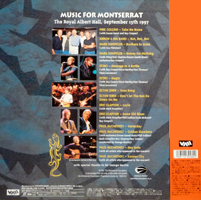|
Additional
comments |
Some of rock music's biggest stars
performed at a benefit concert in London on 15th September 1997 to raise
money for the volcano-ravaged Caribbean island of Montserrat. The concert
has been organised by Sir George and Lady Martin together with Harvey
Goldsmith to raise funds for the victims of the Soufriere volcano on the
island of Montserrat which has been in a continuous state of eruption since
July 1993. The most recent explosion in June 1997 killed 19 people and
rendered 1500 homeless. Beatles producer George Martin, who has a luxury
home and recording studio on the island, hopes to raise at least £500,000.
Mark Knopfler is one of the artists that contributes to this amazing show.
12 inch LaserDisc, NTSC format, Japanese edition including seperate
info-sheet and Obi.
|
|
Extra information Obi |
An Obi strip is traditionally a strip of paper
looped around the left side or folded over the top of Japanese LP albums.
Obi strips are also found folded over the left side of music CD's, video
games, DVD's and even on the covers of books when they are sold new. The
Japanese word "Obi" refers to the traditional sash or belt worn with a
kimono. The features of the obi strip include the title of the product
usually in phonetic Japanese, the track listings, other information such as
price, catalog number and information on related releases or artists from
that same record company.
|
|
Laserdisc information |
The LaserDisc (LD) is an obsolete home video disc
format, and was the first commercial optical disc storage medium. Initially
marketed as Discovision in 1978, the technology was licensed and sold as
Reflective Optical Videodisc, Laser Videodisc, Laservision, Disco-Vision,
DiscoVision, and MCA DiscoVision until Pioneer Electronics purchased the
majority stake in the format and marketed LaserDisc in the mid to late
1980's. While LaserDisc produced a consistently higher quality image than
its rivals, the VHS and Betamax systems, the laserdisc never obtained more
than a niche market with videophiles in America. In Europe, it remained
largely an obscure format. It was, however, much more popular in Japan and
in the more affluent regions of South East Asia, such as Hong Kong and
Singapore. Laserdisc was the prevalent rental video medium in Hong Kong
during the 1990's. The technology and concepts provided with the Laserdisc
would become the forerunner to Compact Discs and DVDs. |

